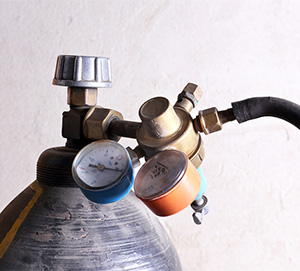TWS is a Great Training Option for Everyone
Learn more about how we can prepare you to advance your career.
Welding safety requires knowledge of the equipment being used, specifically proper setup, handling, maintenance, and safety practices. One piece of equipment that is common to all gas, or oxyfuel, welding processes is the welding pressure regulator. 1
The Pressure Regulator’s Role in Oxyfuel Welding
Oxyfuel welding gets its name from the gases the process uses: oxygen and fuel. The most common fuel gas is acetylene, but twenty-five other gases can be used. This type of welding relies on a high-temperature flame to melt the metals to be joined. Common applications include automotive repair, metal fabrication, artisan welding, and plumbing. 2 The process can be broken down into four main steps:
Step 1: Oxygen and fuel gases flow from two pressured cylinders through cylinder valves into their respective welding pressure regulators.
Step 2: The welding pressure regulators reduce the pressure of the gases.
Have You Considered a Career in the Skilled Trades?
Fill out the form to recieve a no obligation info packet.
Step 3: Once at a lower, working pressure, the gases flow through flexible hoses to the torch.
Step 4: The torch does two things. First, it controls the flow of the gases to the tip. Second, it combines the gases into the right proportion so they combust properly at the end of the tip, creating the flame. 3
The main job of the welding pressure regulator is to control the pressure of the gases used in oxyfuel welding. For example, the pressure acetylene gas is under in the cylinder is typically more than seven times greater than the pressure of the gas in the torch. 4
Welding Pressure Regulator Parts & Process
A welding pressure regulator relies on three parts to reduce the pressure of gas coming from the cylinder and traveling to the hose: the screw, the diaphragm, and the high-pressure valve. Following is an overview of the process:
Step 1: An adjusting screw is turned inward, pushing a spring into a flexible diaphragm.
Step 2: When the diaphragm is displaced by the spring, it opens the high-pressure value. This allows more gas to flow into the regulator from the cylinder.
Step 3: When the pressure of the gas cancels out the pressure from the spring, the diaphragm returns to its original position. This causes the high-pressure valve to close.
Additional Parts
Regulator Gauges
Welding pressure regulators usually have one to two pressure gauges.
- Working Pressure: Displays the pressure of the gases in the regulator, which is always less than the pressure of the gases at the torch.
- Cylinder Pressure: Indicates the pressure and amount of gas in the cylinder.
Safety Devices
Two types of safety devices are commonly found on welding pressure regulators. They prevent extremely high pressures from damaging the regulator.
- Safety Release Valves: a valve consisting of a small ball tightly held with a spring to a seat. Once excessive pressure has been released, the valve will reset.
- Safety Disc: A thin disc the will burst to release excessive pressure. The disc must be replaced after use. 5
Welding Pressure Regulator Safety

It’s important to follow safety guidelines when oxyfuel welding. Here are some tips for using welding pressure regulators correctly.
- When opening the cylinder, do not stand directly in front of the regulator. Keep regulators away from sparks or flames at the worksite.
- Check for leaks in the diaphragm. If using fuel gases, set the regulator to 14 pounds per square inch gauge (psig); use 45 psig for all other gases and oxygen. Put your finger on the vent hole and apply a leak-detecting solution. If there are bubbles on the vent when you remove your finger, there is a leak.
- A leaky diaphragm could be an indication of a leak in the high-pressure valve seat. This problem can cause creep: increasing pressure on the working side of the regulator. Too much pressure on the working side can damage not only the diaphragm but also the hoses, gauges, and other equipment.
- When shutting down the oxyfuel system, always back off the adjusting screw to release pressure on the spring and diaphragm and prevent damage to them.
- Never oil a regulator. Only clean it with a dry, oil-free towel.
- Always have a trained technician perform repair work on a welding pressure regulator. 6 7
Welding Equipment Safety
As you can see, even small pieces of welding equipment like welding pressure regulators can have serious safety consequences if used incorrectly. Whether you’re still taking welding classes or already in the field, observe care and safety guidelines when using any piece of welding equipment.
1 – Title: Welding Principles and Applications; Author: Larry Jeffus; Delmar Cengage Learning; Seventh Edition; Textbook page 756, 777
2 – http://modernwelding.net/oxy-acetylene-welding/
3 – Title: Welding Principles and Applications; Author: Larry Jeffus; Delmar Cengage Learning; Seventh Edition; Textbook page 756-757
4 – http://www.twi-global.com/technical-knowledge/job-knowledge/equipment-for-oxyacetylene-welding-013/
5 – Title: Welding Principles and Applications; Author: Larry Jeffus; Delmar Cengage Learning; Seventh Edition; Textbook page 757-760
6 – chrome-extension://gbkeegbaiigmenfmjfclcdgdpimamgkj/views/app.html
7 – Title: Welding Principles and Applications; Author: Larry Jeffus; Delmar Cengage Learning; Seventh Edition; Textbook page 761-762
This blog has been labeled as archived as it may no longer contain the most up-to-date data. For a list of all current blog posts, please visit our blog homepage at https://www.tws.edu/blog/







